fuel consumption MERCEDES-BENZ METRIS 2016 MY16 Operator’s Manual
[x] Cancel search | Manufacturer: MERCEDES-BENZ, Model Year: 2016, Model line: METRIS, Model: MERCEDES-BENZ METRIS 2016Pages: 310, PDF Size: 7.28 MB
Page 274 of 310
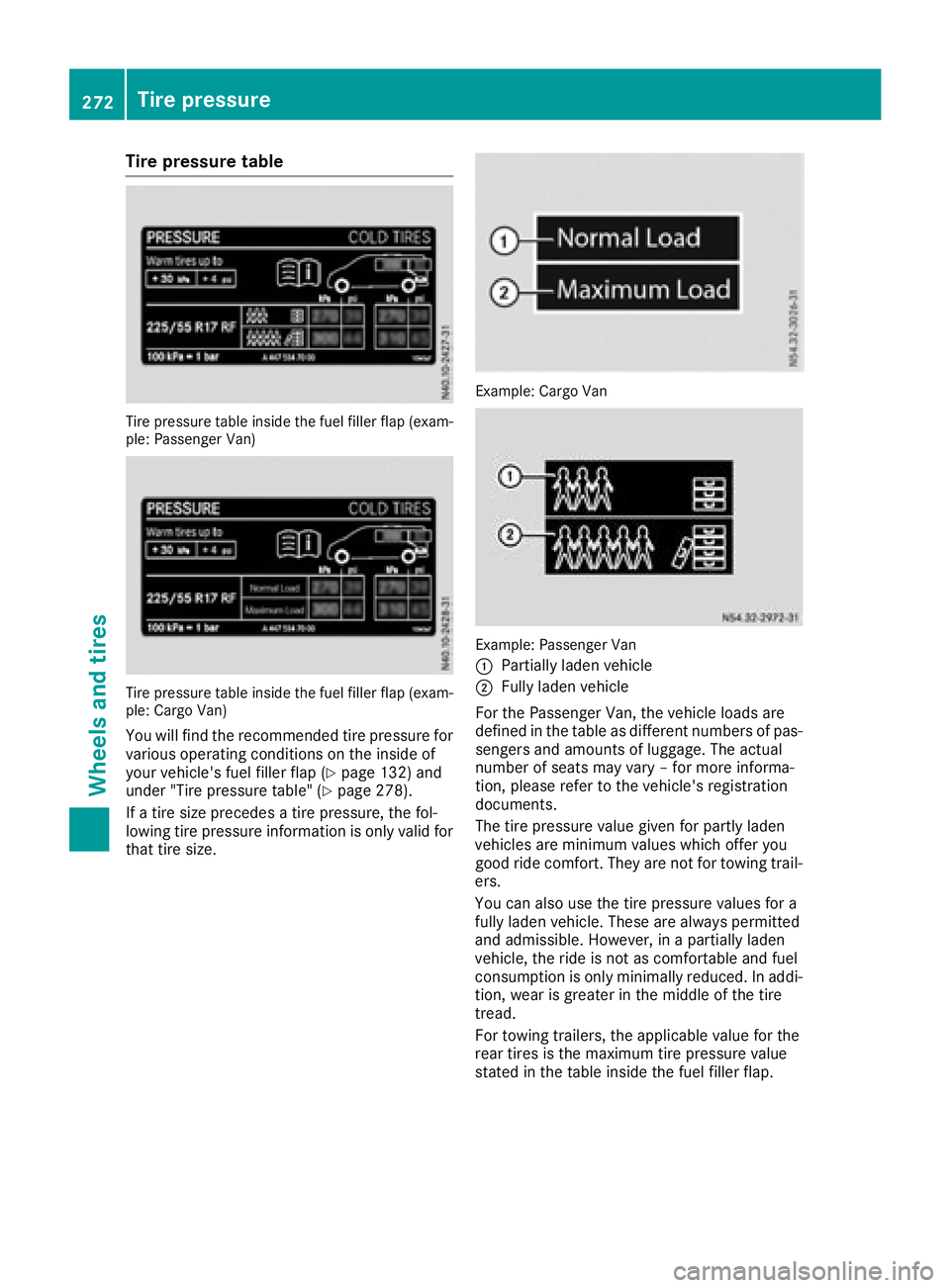
Tire pressure table
Tire pressure table insidethe fuel fille rflap( exam-
ple: Passenge rVan)
Tire pressure table insid ethe fuel fille rflap( exam-
ple: Cargo Van)
Yo uw illf ind the recommende dtire pressure for
various operating conditions on the insid eof
your vehicle's fuel fille rflap(
Ypage 132 )and
under "Tire pressure table "(Ypage 278).
If at ire size precedes atire pressure, the fol-
lowing tire pressure informatio niso nlyv alid for
thatt ire size.
Example: Cargo Van
Example: Passenge rVan
:
Partiall yladen vehicle
;Fully lade nvehicle
For the Passenge rVan,the vehicl eloads are
define dinthe table as different numbers of pas-
sengers and amounts of luggage.T he actual
numbe rofseats mayv ary–f or mor einforma-
tion, please refer to the vehicle's registration
documents.
The tire pressure valu egiven for partly laden
vehicles ar eminimu mvalues which offer you
good rid ecomfort. The yarenot for towing trail-
ers.
Yo uc an also us ethe tire pressure values for a
full yladen vehicle. These ar ealway spermitted
and admissible. However, in apartiall yladen
vehicle, the rid eisnot as comfortabl eand fuel
consumption is onl yminimall yreduced. In addi-
tion, wear is greate rinthe middl eofthe tire
tread.
For towing trailers ,the applicabl evalue for the
rea rtire sist he maximum tire pressure value
stated in the table insid ethe fuel fille rflap.
272Tire pressure
Wheel sand tires
Page 275 of 310
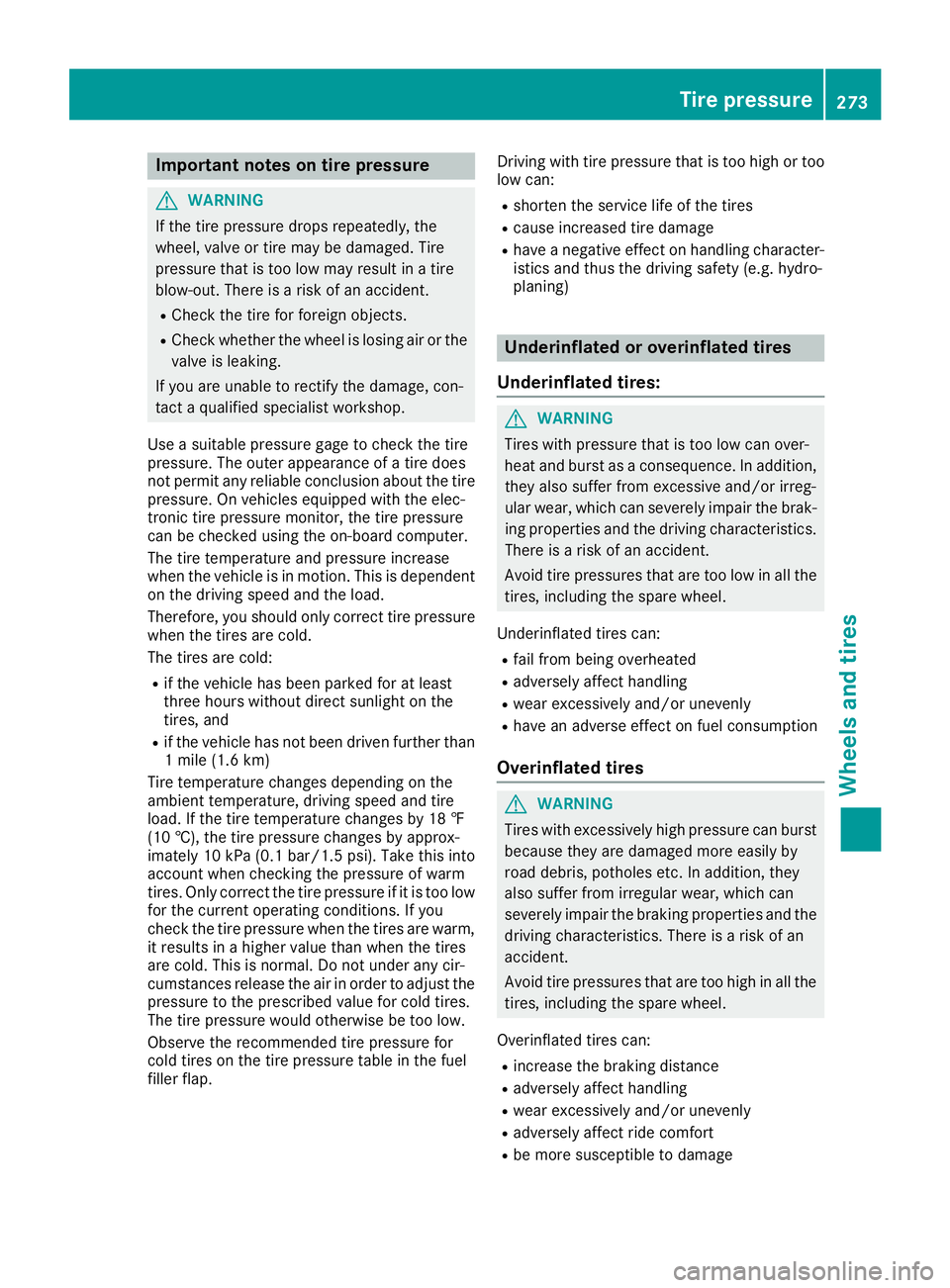
Important notes on tire pressure
GWARNING
If th etirep ressur edrops repeatedly, th e
wheel, valv eortirem ay be damaged. Tir e
pressur ethatist oolow may result in atire
blow-out .Ther eisar iskofana ccident.
RCheckthe tire for foreign objects .
RCheckwhether th ewhee lislosing air or th e
valv eisl eaking .
If you are unable to rectify th edamage, con-
tac taq ualified specialist workshop.
Use asuitable pressur egage to chec kthe tire
pressure. The outer appearanc eofatired oes
no tp ermit any reliable conclusio nabout th etire
pressure. On vehicles equipped wit hthe elec -
tronic tire pressur emonitor, th etirep ressur e
can be checke dusingthe on-board computer.
The tire temperature and pressur eincreas e
when th evehicl eisinm otion.This is dependen t
on th edriving spee dand th eload.
Therefore, you should only correc ttirep ressur e
when th etires are cold.
The tires are cold:
Rif th evehicl ehas been parked for at least
three hour swithout direct sunligh tonthe
tires ,and
Rif th evehicl ehas no tbeen driven further than
1m ile(1.6 km )
Tire temper aturechanges dependingont he
ambient temperature, driving speeda nd tire
load. If th etiret em peratur echanges by 18 ‡
(10 †), th etirep ressure changes by approx-
imately 10 kP a(0.
1b ar/1.5 psi). Taket hisi n
to
accountw hen checking th epressure of warm
tires. Only correc tthe tirep ressure if it is to olow
for th ecurren toperatin gconditions. If you
check th etirep ressure when th etires are warm,
it results in ahigher value than when th etires
are cold. This is normal. Do no tunde rany cir-
cumstances release th eair in orde rtoadjustthe
pressure to th eprescribed value for col dtires.
The tir epressure would otherwise be to olow.
Observ ethe recommended tir epressure for
col dtires on th etirep ressure table in th efuel
fille rflap. Drivin
gwith tir epressure that is to ohigh or too
low can:
Rshorte nthe servic elife of th etires
Rcaus eincreased tir edamage
Rhave anegativ eeffect on handlingc haracter-
istics and thus th edriving safety (e.g. hydro-
planing)
Underinflated or overinflated tires
Underinflated tires:
GWARNING
Tire swith pressure that is to olow can over-
heat and burs tasaconsequence. In addition,
they also suffer from excessive and/or irreg-
ular wear, whichc an severelyimpair thebrak-
ing properties and th edriving characteristics.
Thereisar isk of an accident.
Avoid tir epressurest hata re to olow in all the
tires, includingt hesparew heel.
Underinflate dtires can:
Rfail from beingo verheated
Radversely affect handling
Rwear excessively and/or unevenly
Rhave an adverse effect on fuel consumption
Overinflated tires
GWARNING
Tire swith excessively high pressure can burst
because they are damage dmoree asily by
road debris, potholes etc. In addition,t hey
also suffer from irregular wear, whichc an
severelyi mpair thebraking properties and the
driving characteristics .Thereisar isk of an
accident.
Avoid tir epressurest hatare to ohigh in all the
tires, includingt hesparew heel.
Overinflated tires can:
Rincreas ethe braking distance
Radversely affect handling
Rwear excessively and/or unevenly
Radversely affect ride comfort
Rbe mores usceptible to damage
Tirep ressure273
Wheels and tires
Z
Page 292 of 310
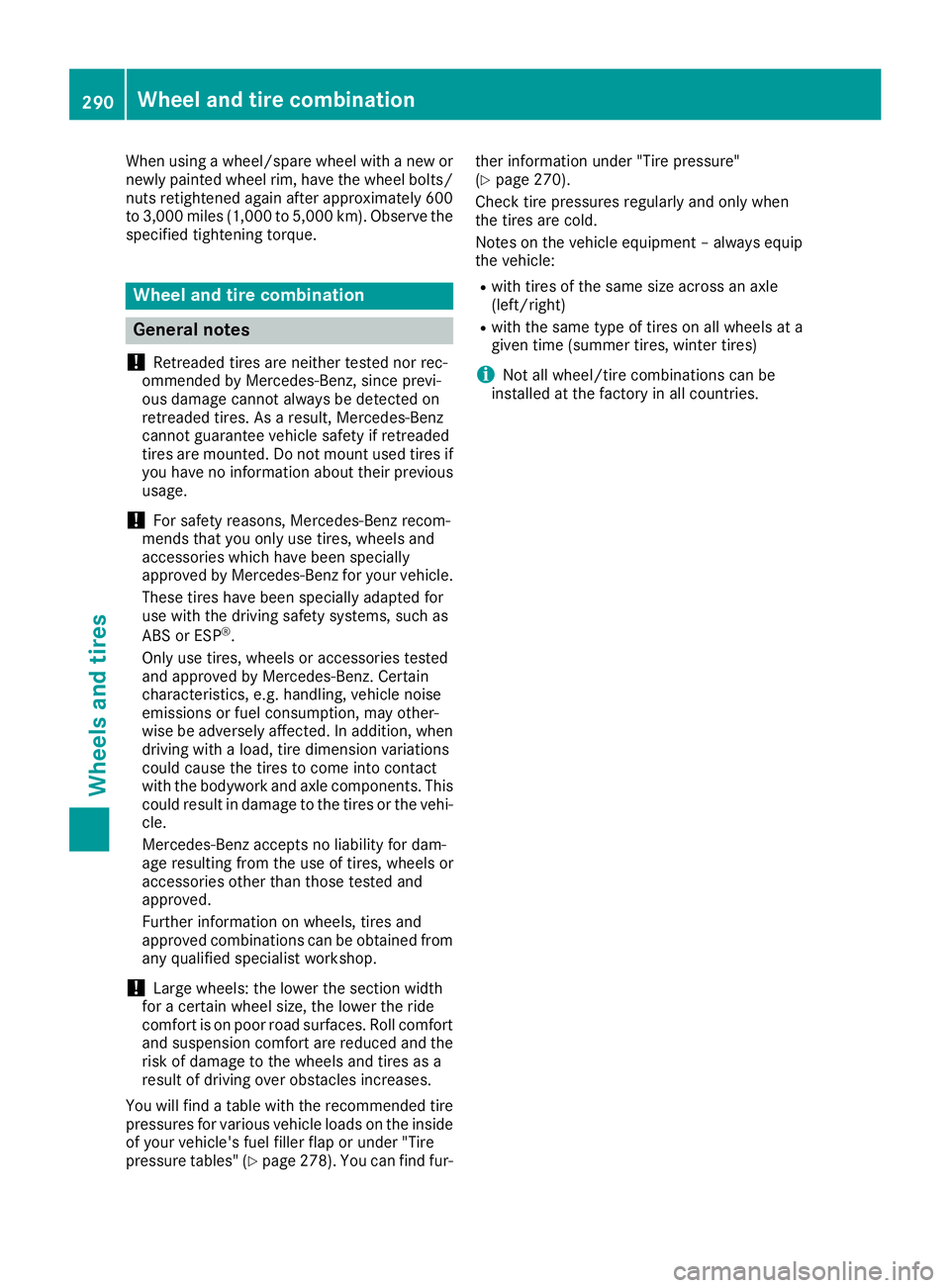
When usingawheel/spare wheel with anew or
newly painted wheel rim, have the wheel bolts/
nuts retightened again after approximately 600
to 3,000 miles (1,000 to 5,000 km). Observe the
specified tightening torque.
Wheel and tirec ombination
General notes
!
Retreaded tires are neither tested nor rec-
ommended by Mercedes-Benz,s ince previ-
ous damage cannot alwaysbed etected on
retreaded tires. As aresult, Mercedes-Benz
cannot guarantee vehicle safety if retreaded
tires are mounted. Do not mount used tires if you have no information about their previous
usage.
!For safety reasons, Mercedes-Benz recom-
mends that you only use tires, wheels and
accessories which have been specially
approved by Mercedes-Benz for your vehicle.
These tires have been specially adapted for
use with the driving safety systems, such as
ABS or ESP
®.
Only use tires, wheels or accessories tested
and approved by Mercedes-Benz .Certain
characteristics, e.g. handling, vehicle noise
emissions or fuel consumption, may other-
wise be adversely affected. In addition, when
driving with aload, tire dimension variations
could cause the tires to come into contact
with the bodywork and axle components. This
could result in damage to the tires or the vehi-
cle.
Mercedes-Benz acceptsnol iability for dam-
age resulting from the use of tires, wheels or
accessories other than those tested and
approved.
Further information on wheels, tires and
approved combinations can be obtained from
any qualified specialist workshop.
!Large wheels: the lower the section width
for acertain wheel size, the lower the ride
comfort is on poor road surfaces. Roll comfort and suspension comfort are reduced and the
risk of damage to the wheels and tires as a
result of driving over obstacles increases.
You will find atable with the recommended tire
pressures for various vehicle loads on the inside
of your vehicle's fuel filler flap or under "Tire
pressure tables" (
Ypage 278). You can find fur- ther information under "Tire pressure"
(
Ypage 270).
Check tire pressures regularly and only when
the tires are cold.
Notes on the vehicle equipment –alwayse quip
the vehicle:
Rwith tires of the same size across an axle
(left/right)
Rwith the same type of tires on all wheels at a
given time (summer tires, winter tires)
iNot all wheel/tire combinations can be
installed at the factory in all coun tries.
290Wheel and tirecombination
Wheels and tires
Page 299 of 310
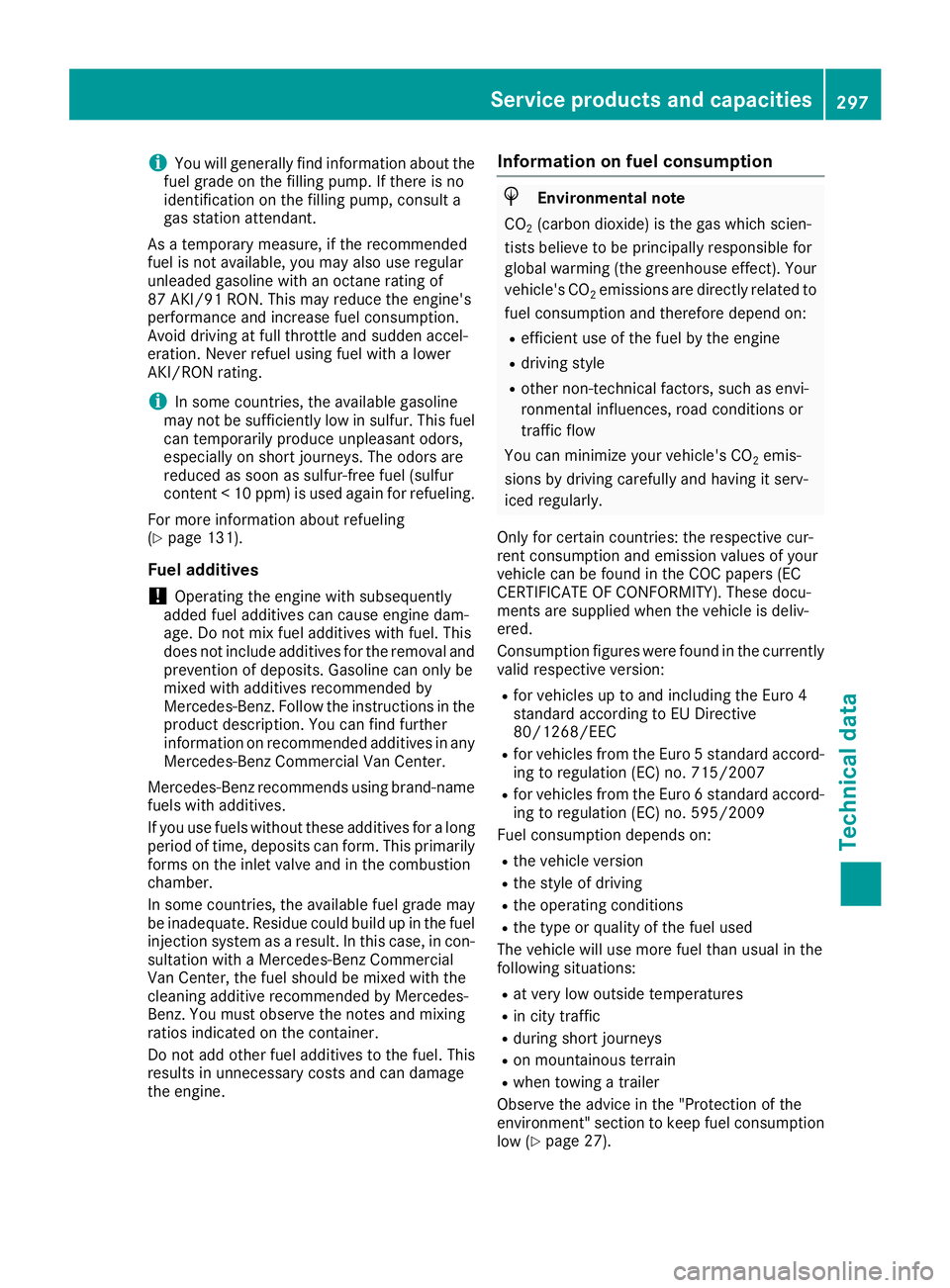
iYou will generally findinformation about the
fuel grade on the filling pump. If there is no
identification on the filling pump, consult a
gas station attendant.
As atemporary measure, if the recommended
fuel is not available, you may also use regular
unleaded gasolinew ith an octane ratingof
87 AKI/91R ON. This may reduce the engine's
performance and increase fuel consumption.
Avoid drivingatf ull throttle and sudden accel-
eration. Never refuel using fuel with alower
AKI/RON rating.
iIn some countries, the available gasoline
may not be sufficiently low in sulfur. This fuel
can temporarily produceu npleasantodors,
especially on shortj ourneys. The odors are
reduce dassoon as sulfur-free fuel (sulfur
conten t<10 ppm) is used again for refueling.
For more information about refueling
(
Ypage 131).
Fuel additives
!Operating the engin ewith subsequently
added fuel additives can cause engin edam-
age. Do not mix fuel additives with fuel. This
does not include additives for the removal and
prevention of deposits. Gasoline can only be
mixe dwith additives recommended by
Mercedes-Benz. Follow the instructions in the
productd escription .You can findf urther
information on recommended additives in any
Mercedes-Ben zCommercial Van Center.
Mercedes-Ben zrecommends using brand-name
fuels with additives.
If you use fuels without these additives for along
period of time, depositsc an form.This primarily
formsont he inlet valve and in the combustion
chamber.
In some countries, the available fuel grade may
be inadequate. Residue could build up in the fuel
injection syste masaresult.Int his case, in con-
sultation with aMercedes-Ben zCommercial
Van Center, the fuel should be mixe dwith the
cleaning additiv
erecommen ded
by Mercedes-
Benz. You must observet he notes and mixing
ratio sindicated on the container.
Do not add other fuel additives to the fuel. This
resultsinu nnecessary cost sand can damage
the engine.
Information on fuel consumption
HEnvironmental note
CO
2(carbo ndioxide )isthe gas which scien-
tist sbelieve to be principally responsible for
global warming( the greenhouse effect). Your
vehicle's CO
2emissions are directly related to
fuel consumption and therefore dependo n:
Refficient use of the fuel by the engine
Rdrivingstyle
Rother non-technical factors, such as envi-
ronmental influences, road condition sor
traffic flow
You can minimize your vehicle's CO
2emis-
sionsbyd rivingcarefully and havingits erv-
iced regularly.
Only for certain countries: the respectiv ecur-
rentc onsumption and emissionv alues of your
vehicle can be foundint he COC papers (EC
CERTIFICATE OF CONFORMITY). These docu-
ments are supplied when the vehicle is deliv-
ered.
Consumption figures were foundint he currently
valid respectiv eversion:
Rfor vehicles up to and including the Euro 4
standard accordingtoEUD irective
80/1268/EEC
Rfor vehicles from the Euro 5standar daccord-
ing to regulation (EC )no. 715/2007
Rfor vehicles fromt he Euro6standard accord-
ing to regulation (EC )no. 595/2009
Fue lconsumption depends on:
Rthe vehicl eversion
Rthe style of driving
Rthe operating conditions
Rthe typ eorquality of the fuel used
The vehicl ewillu se mor efuelthanu sualin the
following situations:
Rat ver ylow outside temperatures
Rin city traffic
Rdurin gshort journeys
Ron mountainou sterrain
Rwhen towing atrailer
Observe the advic einthe "Protectio no
fthe
environment" sectio ntokeepf uelconsumption
lo w(
Ypage 27).
Service products and capacities297
Technica ldata
Z
Page 300 of 310
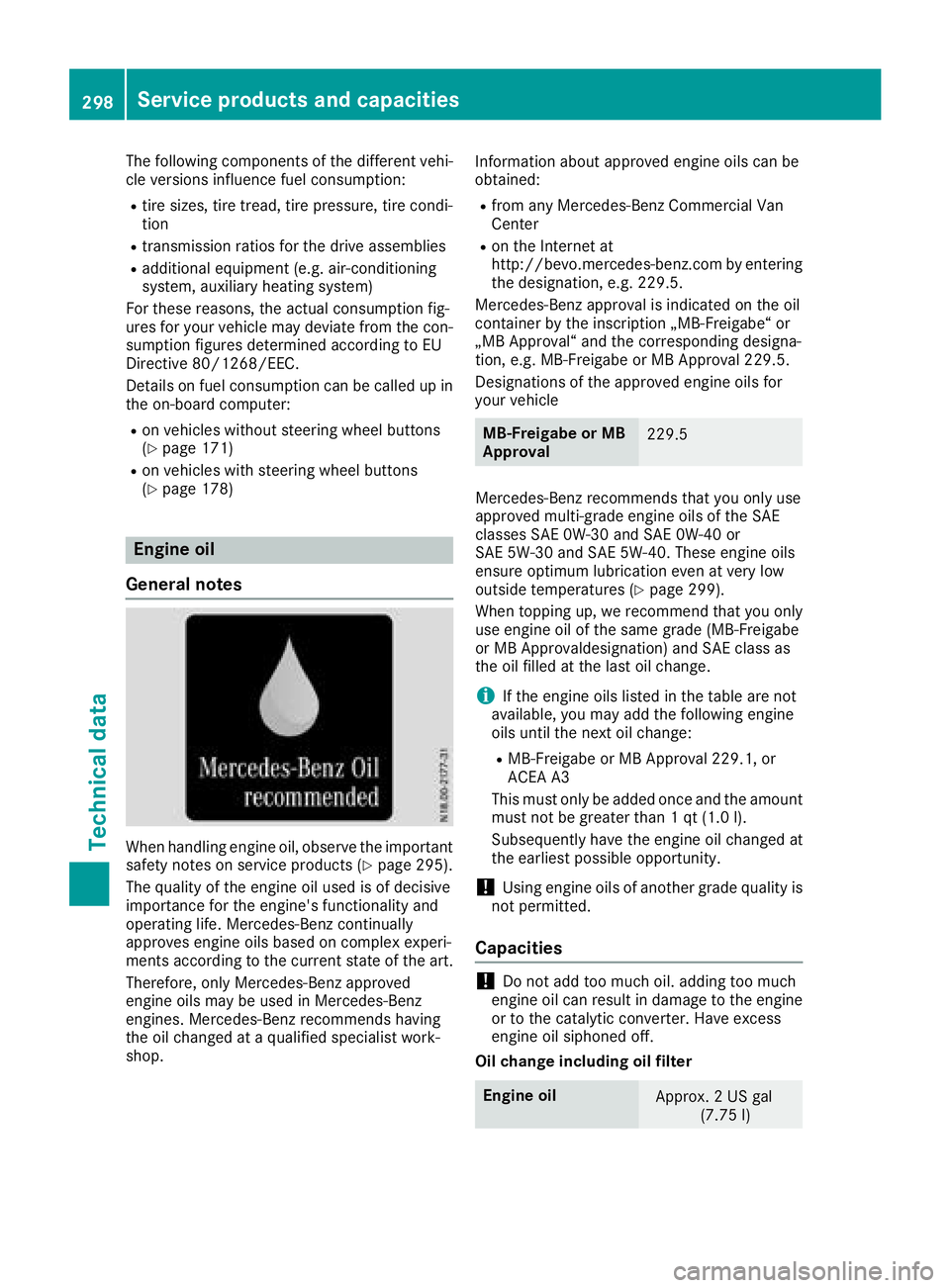
The following components of the different vehi-
cle versions influence fuel consumption:
Rtire sizes, tire tread, tire pressure, tire condi-
tion
Rtransmission ratios for the drive assemblies
Radditional equipment (e.g. air-conditioning
system, auxiliary heating system)
For these reasons, the actual consumption fig-
ures for your vehicle may deviate from the con-
sumption figures determined according to EU
Directive 80/1268/EE C.
Detail sonfuelconsumption can be calle dupin
the on-board computer:
Ron vehicles withou tsteerin gwheel buttons
(Ypage 171)
Ron vehicles with steerin gwheel buttons
(Ypage 178)
Engine oil
General notes
When handling engine oil, observe the important
safety note sonserviceproducts (Ypage 295).
The quality of the engine oi lusedisofd ecisive
importance for the engine's functionality and
operating life. Mercedes-Benz continually
approves engine oils based on comple xexperi-
ments according to the current state of the art.
Therefore ,onlyM ercedes-Benz approved
engine oils maybeu sedinM ercedes-Benz
engines. Mercedes-Benz recommends having
the oi lchange dataq ualified specialis twork-
shop. Informatio
nabout approved engine oils can be
obtained:
Rfroma ny Mercedes-Benz Commercial Van
Center
Ron the Internet at
http://bevo.mercedes-benz.co mbyenter ing
th ed esignation ,e.g.2 29.5 .
Mercedes-Ben zapprova lisindicate dont heoil
container by th einscriptio n„MB-Freigabe “or
„MB Approval“ and th ecorre spondin gdesigna-
tion ,e.g.M B-Freig abe or MB Approval 229.5.
Designation softheapprove dengineo ils for
your vehicl e
MB-Freigabe or MB
Approval229.5
Mercedes-Ben zrecommends that you only use
approve dmulti-grade engin eoils of th eSAE
classe sSAE 0W-30 and SA E0W-40 or
SA E5 W-30 and SA E5W-40. These engin eoils
ensur eoptimum lubrication eve natveryl ow
outside temperatures (
Ypage 299).
Whe ntoppin gup, we recommen dthaty ou only
use engin eoil of th esam egrade (MB-Freigabe
or MB Approvaldesignation )and SA Eclass as
th eo il filled at th elast oil change.
iIf th eengineo ils listed in th etable are no t
available, you may add th efollowin gengine
oils until th enexto il change:
RMB-Freigabe or MB Approval 229.1, or
ACE AA3
This mus tonlybea dded once and th eamount
mus tnotbe greate rtha n1q t(1.0l ).
Subsequentl yhavet he engin eoil changed at
th ee arliest possibl eopportunity.
!Using engin eoils of another grade qualit yis
no tp ermitted.
Capacities
!Do no tadd to omucho il. addin gtoo muc h
engin eoil can result in damage to th eengine
or to th ecatalytic converter. Hav eexces s
engin eoil siphoned off .
Oil change includin goil filter
Engin eoilApprox. 2USgal
(7.75 l)
298Service products and capacities
Technical data
Page 301 of 310
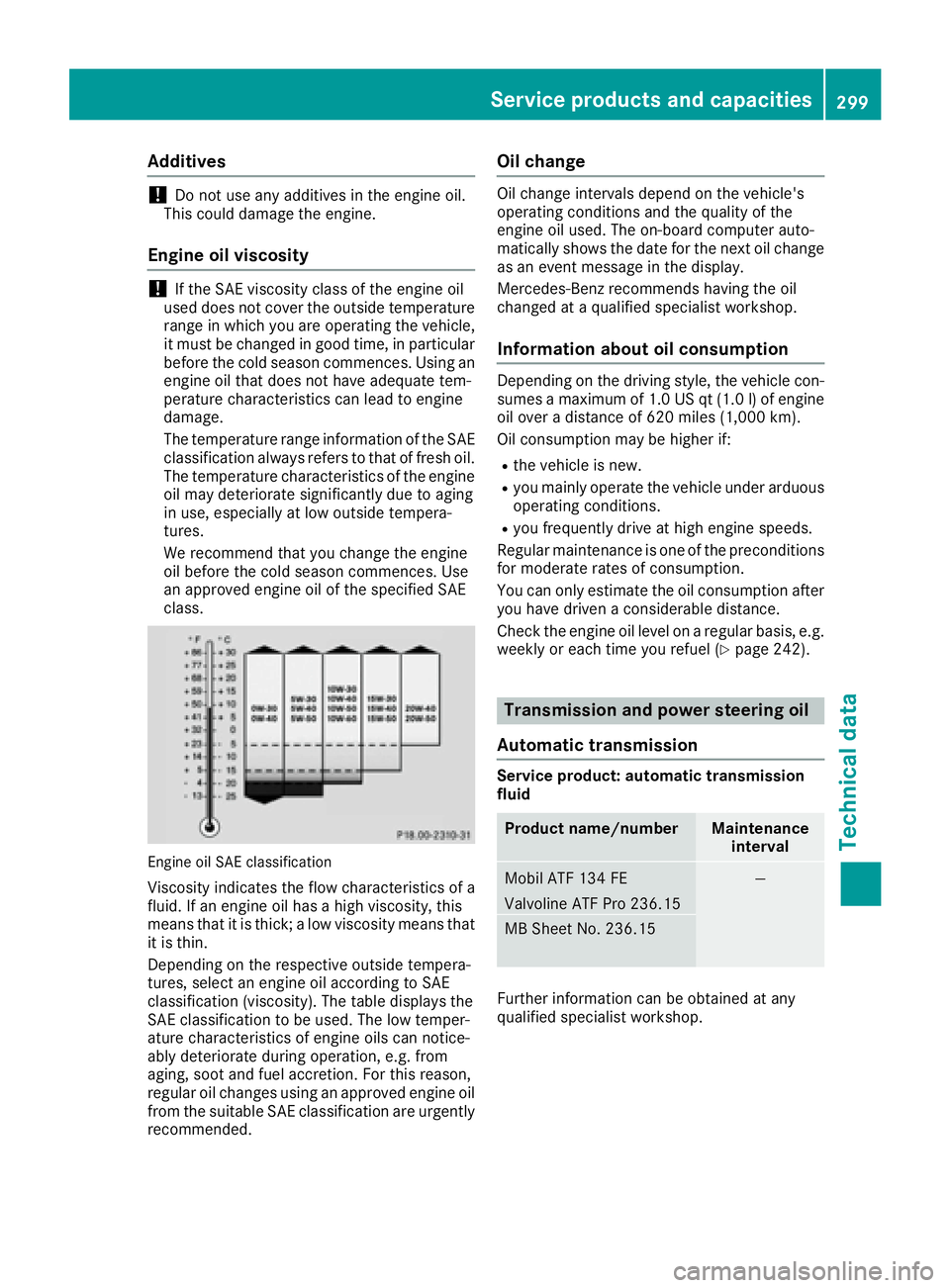
Additives
!Do notuse any additive sintheengin eoil.
This could damag ethe engine.
Engineo il viscosity
!If theSAE viscosit yclassoft heengin eoil
used does no tcover th eoutside temperature
range in whic hyou are operating th evehicle,
it mus tbechanged in goo dtime, in particular
before th ecolds eason commences. Using an
engin eoil that does no thavea dequate tem-
peratur echaracteristics can lead to engin e
damage.
The temperature range information of th eSAE
classification always refers to that of fresh oil.
The temperature characteristics of th eengine
oil may deteriorat esignificantly due to agin g
in use, especially at low outside tempera-
tures.
We recommen dthaty ou chang ethe engin e
oil before th ecolds eason commences. Use
an approve dengineo il of th especifie dSAE
class.
Engin eoil SA Eclassification
Viscosit yindicates th eflowc haracteristics of a
fluid .Ifane ngineo il has ahigh viscosity, this
mean stha titi sthick ;al ow viscosit ymean stha t
it is thin.
Dependin gontherespective outside tempera-
tures, select an engin eoil according to SA E
classification (viscosity). The table displays th e
SA Ec lassification to be used .The low temper-
atur echaracteristics of engin eoils can notice -
ably deteriorat eduring operation ,e.g.f ro m
aging, soo tand fuel accretion .For this reason ,
regular oil changes usin ganapprove dengineo il
from th esuitable SA Eclassification are urgently
recommended.
Oil change
Oil chang eintervals depend on th evehicle's
operating condition sand th equalit yoft he
engin eoil used .The on-board computer auto -
matically shows th edatef or th enexto il chang e
as an event message in th edisplay.
Mercedes-Benz recommends having th eoil
changed at aqualified specialist workshop .
Information abou toil consump tion
Dependin gonthedrivin gstyle, th evehicl econ-
sumes amaximum of 1. 0USqt(1.0l )ofe ngine
oil over adistance of 620 miles (1,000 km).
Oil consumption may be higher if:
Rthe vehicle is new.
Ryou mainly operate the vehicle under arduous
operating conditions.
Ryou frequently drive at high engine speeds.
Regularm aintenance is one of the preconditions
for moderate rates of consumption.
You can only estimate the oil consumption after
you have driven aconsiderable distance.
Check the engine oil level on aregular basis, e.g.
weekly or each time you refuel (
Ypage 242).
Transmission and power steering oil
Automatic transmission
Service product: automatic transmission
fluid
Product name/numberMaintenance interval
Mobil ATF 134 FE
Valvoline ATF Pro 236.15—
MB Sheet No. 236.15
Further information can be obtained at any
qualified specialist workshop.
Service products and capacities299
Technical data
Z